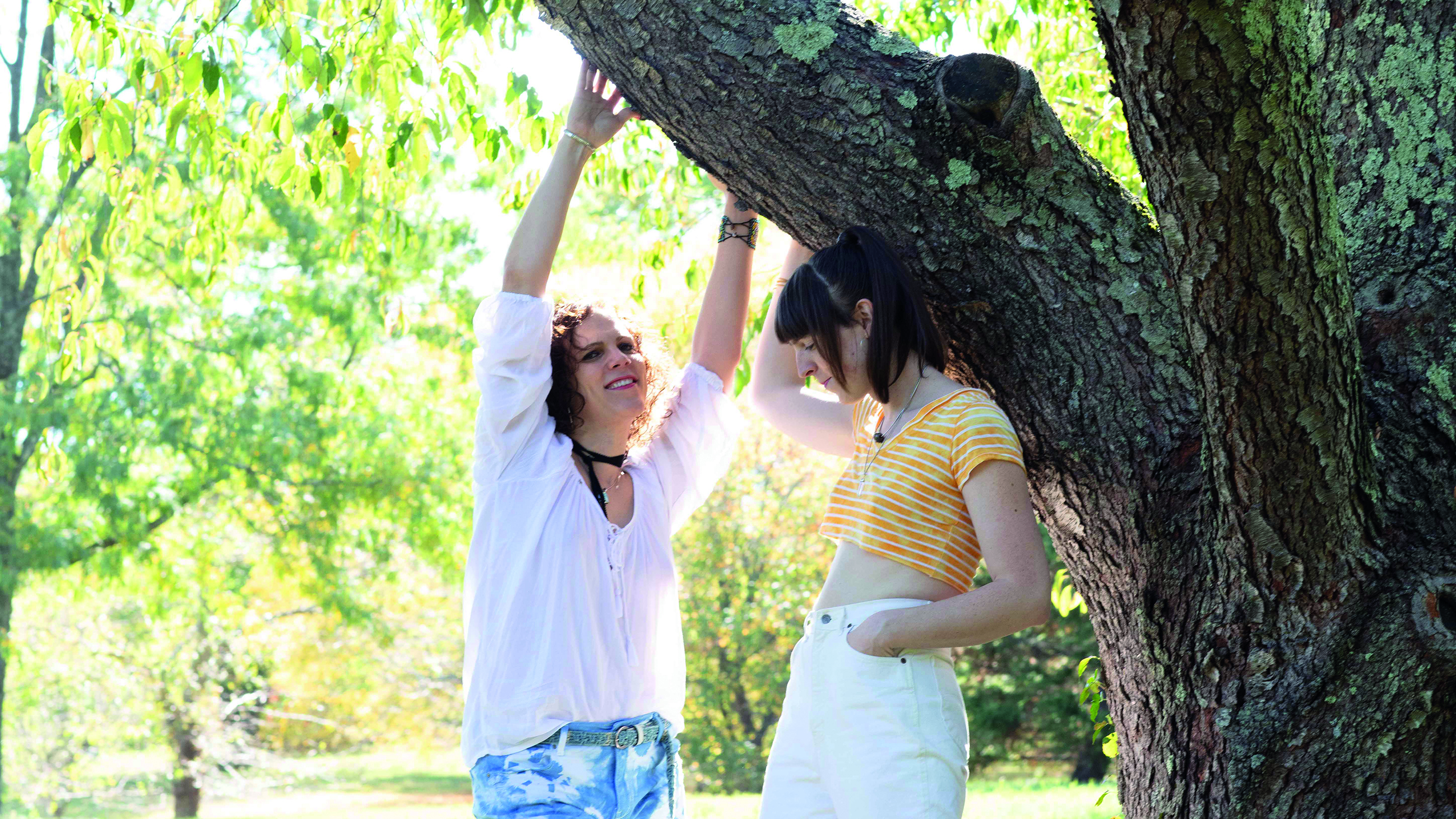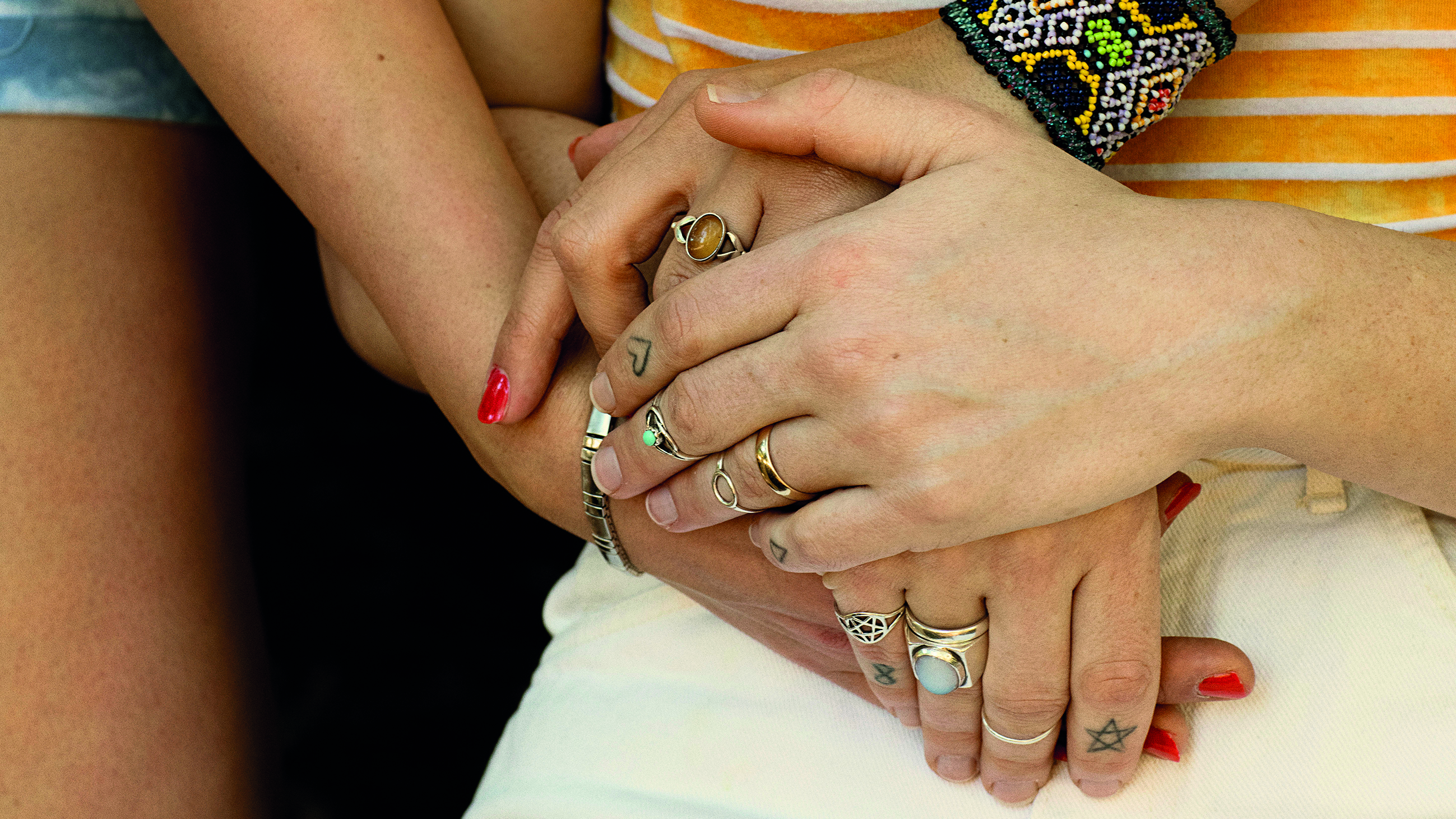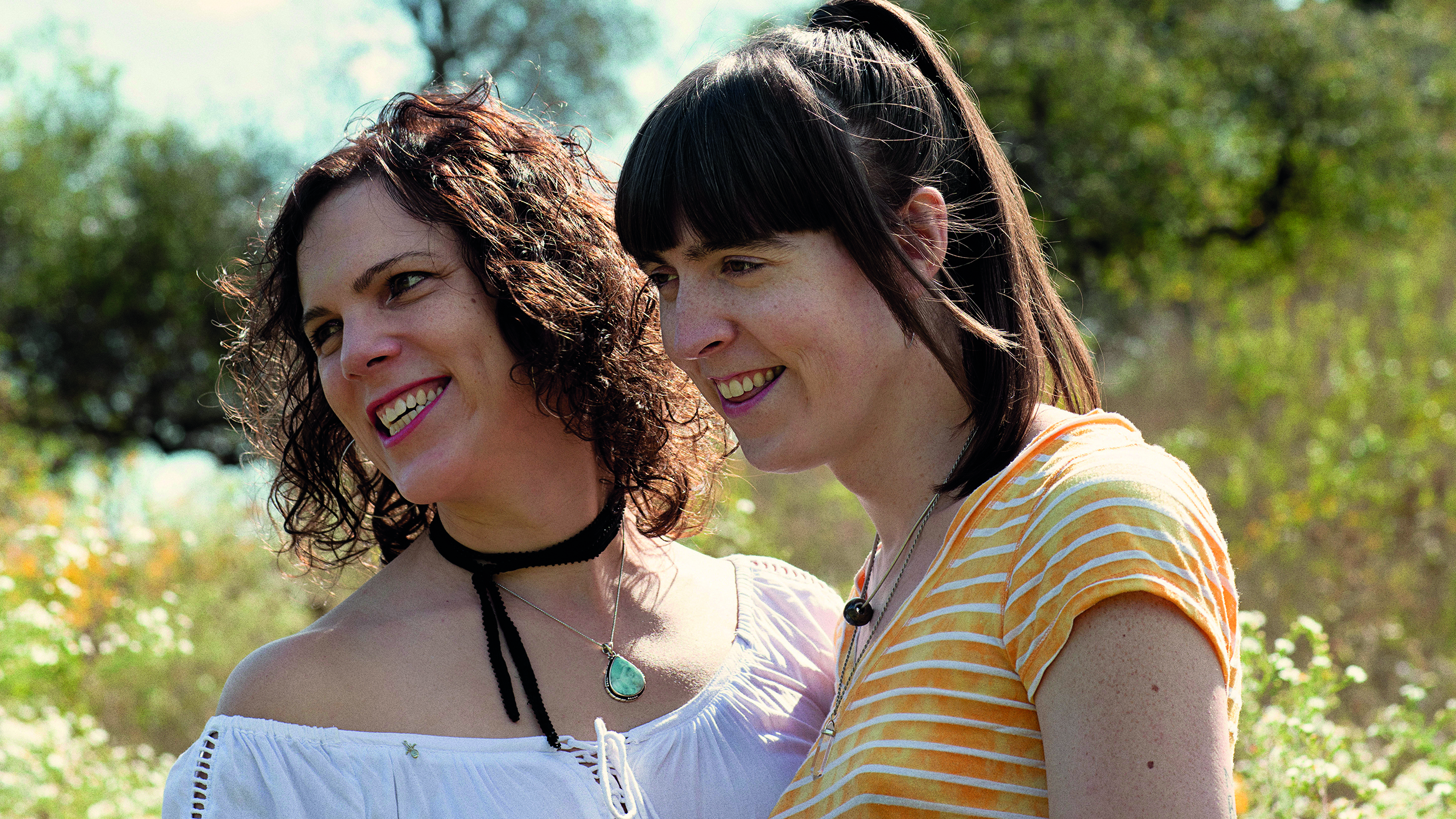Octo Octa and Eris Drew: "The future of music is manifesting in bedrooms all over the world"
The vinyl-loving DJing duo on staying creative under lockdown

US DJs and producers Eris Drew and Octo Octa (aka Maya Bouldry-Morrison) each made a name for themselves in electronic music individually, but in recent years, coming together as both partners and musical collaborators, the pair have become a serious force to be reckoned with. Known for putting their own distinctive, eclectic spin on classic house and rave sounds, the pair have become one of the scene’s most in-demand DJ duos.
Through their releases, DJ sets and T4T LUV NRG the pair have become evangelists for the communal and healing power of dance music, as well as vocal advocates for LGBTQ+ voices within the dance music community.
Their new mix release, fabric presents Octo Octa & Eris Drew was released on 27 November. Recorded purely on vinyl at their cabin in the New Hampshire forests, the pair describe it as, “about letting go and trusting that change is good during a time when the very idea of hope is under challenge”.
We caught up with them remotely to discuss how vinyl fits into their DJing and music-making ethos, as well as how they’ve been spending their time away from clubs in 2020. (Maya and Eris have asked that their answers are credited to the pair of them jointly, except where specifically noted).
Your new fabric mix is all-vinyl - as DJs, why does vinyl still appeal to you as a format to mix with, over and above the comparative convenience of CDJs or digital setups?
“We like interacting with records and collecting. It is easy to form attachments to a vinyl recording as an object. Our accumulated memories are triggered when we play the records live, including when and where we bought them, the parties we played them at, and the friends we shared them with.
“We do a lot of tricks and manipulations with the records, so they are an essential part of how we create a set and perform. The people who support our music and come to our events care about the records. We think our fans would be really disappointed in us if we stopped playing wax.
Get the MusicRadar Newsletter
Want all the hottest music and gear news, reviews, deals, features and more, direct to your inbox? Sign up here.
“Because much of the music we play does not exist digitally, collecting records is our best option for finding unique music.”
Similarly, why do you think vinyl remains so popular with consumers/listeners in the age of streaming?
“Vinyl is a physical artefact that you can hold in your hand. From the artwork on the sleeve, to the shout-outs on the label, to the etchings in the dead wax, there’s so much to take in and form attachments to. They’re historical objects in a sense and contain information beyond just the artist’s name and track title.
“More and more of culture is a projection of consciousness and psyche into a digital device, but records are physical. When you buy an old record, in your hand is a sculpture that plays sound. The message on the wax might be from someone who is gone. The vinyl will most likely survive you. People feel the weight of that when they interact with records.”
For each of you, what was your first exposure to dance music? Where/how did you hear it and in what format did you first start buying records?
OO: “I first came across dance music properly when a friend of mine started sharing some Warp CDs with me. I already liked electronic music and was very much into video game music at the time.
"I grew up in New England and I didn’t have essentially any access to dance music until I got the internet when I was 13, which finally let me hear and find a wider array of music (I specifically became enamored with drum & bass and jungle).
"I bought some very cheap belt-drive Numarks a year or two later and tried to DJ with the few records I was able to come across. I failed pretty miserably at the time, so I then bought a drum machine instead.”
ED: “My first exposure to dance music was watching my mom and dad dance to CJ & Company’s Detroit disco classic, The Devil’s Gun over and over again while it played on the Marantz amp in our living room. It was 1978 and I was three years old. A few years later we would rollerskate to Celebration by Kool & the Gang.
“Flash forward to 1988 - this is the year I started listening to Chicago dance music radio on the neighbour’s hi-fi after the kids went to sleep. I was babysitting and hearing house music DJ mixes for the first time.
"I wanted cool remixes in my collection (which was then mostly tape), so I started going to the local strip mall record shop to buy 12 inches. It still blows my mind that I could pick up LFO’s We Are Back a mile from my parents’ house, which was more than an hour from Chicago proper. Adventures to the city for deeper cuts followed. Wax Trax was first, then Gramaphone, Hiphouse, and Hotjams. All amazing stores.”

What advice or tips would you give new DJs looking to try mixing with turntables and vinyl for the first time?
“The first is technical. Mixing with vinyl is primarily about listening. With CDJs and computers you have visual cues to help you mix. With vinyl you have to rely almost entirely on your ears to guide you.
“First of all, learn to count when trying to mix your records. For example, a typical house record has a 4/4 beat, meaning that there is a kick drum on each beat. The downbeat is the first beat in the measure, so bring in the first beat of the record that you are trying to play on the first beat of the measure of the record playing.
“Eventually you will learn to ‘read the wax’ by looking at the thickness and density of grooves while the record plays to anticipate changes in the track, like breakdowns and choruses.
“The second tip is about state of mind. There are many people who can learn to DJ digitally with proficiency relatively quickly. The same is not true of mixing vinyl. It may take you several years to develop tight beat-matching skills. We have been playing for decades but we still practice to maintain our technique and improve it.
“Our Hot n Ready DJ Tips, Tricks & Techniques contains our full advice, available on the T4T LUV NRG site in French, Spanish, English and German.”
How do you both tend to discover new music and buy records? Do you like to physically dig through things in shops, search out releases online, etc.
“While we use Discogs to find lots of music and mail order from sellers, what we really prefer is to dig in shops for hours and hours on end. We live in the middle of the woods and there are not many record shops near us, especially none that cater to dance music but that doesn’t mean we don’t find amazing records.
“For example, nearby is an antique shop that has a small record store in the back. We talked to the owner to ask if he had any more 12” singles than the small bin he had in the shop. He told us his barn in the back of the property had an attic full of them. Sure enough he has 100 boxes filled to the brim of old record pool records sitting up there. Two sheep guard the records from the floor of the barn. We go there periodically and pull out gems every time. It’s about putting in the hours, searching for great stuff. It’s also just super fun.”
How has 2020 affected your relationship with DJing? Do you think being forced to spend time away from clubs has altered how you experience dance music?
“Dance music is what we both listen to all the time, regardless of being in a club or not. For us it’s packed with so much narrative and emotion that can be accessed regardless of the environment that it’s being heard in. We love DJing and deeply miss the healing experiences that happen on a dancefloor, but playing records at home and thinking about their impact in the future keeps us very engaged. We’re both producers as well, so we are working on music constantly. It’s how we express ourselves. It’s our art in the end.”
Eris – you’ve spoken a lot about the physical and mental power of clubs and dance music. Do you think that’s been lost this year, with people unable to gather in large groups, or is it possible to translate the emotional/communal power of dance music to a world in isolation?
“The isolation certainly challenges the power it has in our individual lives. But it does not reduce it. The dance parties are extremely important and we feel the loss big time, but they are not the sole anchor.
"I think it is important to remember that electronic dance music is in large part a personal subjective engagement with musical energy. For me and so many of my friends, most of our time spent listening to the music and creating it is solitary or in small groups. The music gets charged by these individual interactions.
“What I truly believe is that so much of electronic dance music culture has nothing to do with dancing or parties. Other aspects of the cultural apparatus are intact despite the pandemic. I think of it this way: how many fans of electronic dance music never go to a rave or big festival? How many can’t or don’t dance? The music has lost no power in their lives. The music has lost no power in the lives of individual artists who have channeled their creativity into their works during isolation. As we speak, the future of music is manifesting in bedrooms all over the world.”
How have you mostly been spending the past few months? How has the pandemic affected your creativity as producers?
OO: “This is the first time I have been home for more than a couple weeks in the past four years. We live in a log cabin in the woods so we are surrounded by nature. We go for walks, we work in our studios, we finally eat meals on a regular basis. I’ve played more video games than I ever had time to on tour.
“It’s comforting to be in such a beautiful home, but we miss touring a lot. Being on the road means being able to see friends. Creatively for myself it’s ebbed and flowed. I was able to finish work that would’ve been difficult to finish on the road. We live in the US, which is in such a state of turmoil it can be hard to focus on producing work, but our work is autobiographical so there is plenty happening to process through our art. I’m pushing forward as best as I can.”
ED: “I’ve been on tour without a real break for years, so when we first got home I worked as much as I could in the studio. Songs were pouring out of me. We had just cancelled a truly amazing year of planned events, and I was deeply disappointed. Energy is conserved in a system, so I had to channel all that energy into something, which was the music. Lately, there are days I want to do nothing. But I still go to my studio and work. I use the music to say things that are hard to say right now.”

When clubs/festivals are able to properly come back, do you think they should change in any way? Is there any aspect of dance music culture that you think we should take this opportunity to alter/change/lose?
“Absolutely. Festivals need to invest resources in anti-harassment, anti-racism and harm reduction. For example, policies need to protect indigenous people and people of colour. No headdresses and dashikis worn just for fun. It hurts people. As another example, there is anti-blackness at every level of the industry. It isn’t just about agency rosters and festival line-ups.
“When the scene comes back - and we think it will come back hard - people will want to dissolve and party intensely. So we need to see more drug testing and counselling for difficult situations. Festivals can’t always offer drug testing. It depends on the locality, so ravers also need to take responsibility for protecting each other. Don’t give people stuff you haven’t tested yourself. Invest in the idea of keeping a closer eye on your friends when you party.”
Tell us a little about your creative setups – do you have your own individual setups? What instruments and tools are essential for you?
OO: “We each have a studio in the house, mine upstairs in a loft area and Eris’s in a room downstairs. I have a table with all of my desktop gear plus a few keyboards; a Roland Alpha Juno 2 with a PG-300 (thank you Kim Ann Foxman!), a Korg DW-8000, and a Yamaha DX-27 that’s beat to hell.
“Probably 90% of my music since 2011 has been made all-in-box with Live, but I’ve incorporated my gear more and more over the years. Specific shout-out to the Korg Volca Keys which I think is one of the most underrated acid boxes on the planet; add some reverb to that little unit and it sings beautifully!”
ED: “My turntables face a window overlooking a clearing and the forest. I consider myself a thorough going ‘edge runner’ so this is a perfect place for me to make music. It isn’t unusual to see deer while I work on a mix or write a song.
“My computer and controller keyboard are on a dolly, so I can move them around the room easily. When I mix, the dolly is in an ideal listening position. When I write songs the dolly is to the left of my decks, so I have equal access to the decks, synths and mouse. My songwriting technique is basically to build rhythmic and narrative collages with records and samples while I write most of the melodies and chord progressions through my body with the keyboard.
“My setup is a Pioneer DJM-900 NXS2 mixer, PLX-1000 turntables, Sennheiser HD-25 headphones, Ortofon Elliptical Needles, VPI vacuum record cleaning machine, 61-key MIDI controller, subwoofer, tape deck, Apogee Element soundcard, Waldorf Pulse 2, Waldorf Blofeld, Nord Drum 2, Yamaha Portasound, and various other pedals and boxes. Most of my stuff is in storage in Chicago, but I love my current setup in New Hampshire.”
fabric presents Octo Octa & Eris Drew is out now. For more info visit Bandcamp and Soundcloud.


Future Music is the number one magazine for today's producers. Packed with technique and technology we'll help you make great new music. All-access artist interviews, in-depth gear reviews, essential production tutorials and much more. Every marvellous monthly edition features reliable reviews of the latest and greatest hardware and software technology and techniques, unparalleled advice, in-depth interviews, sensational free samples and so much more to improve the experience and outcome of your music-making.
“I’m looking forward to breaking it in on stage”: Mustard will be headlining at Coachella tonight with a very exclusive Native Instruments Maschine MK3, and there’s custom yellow Kontrol S49 MIDI keyboard, too
“Turns out they weigh more than I thought... #tornthisway”: Mark Ronson injures himself trying to move a stage monitor










